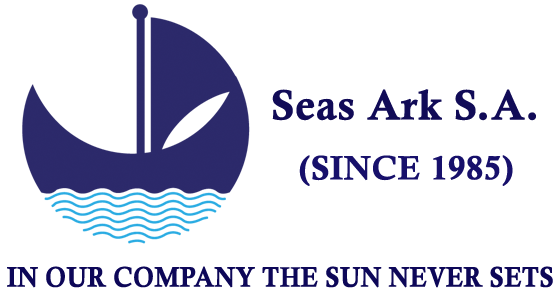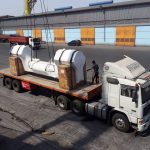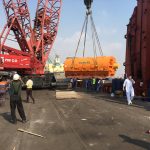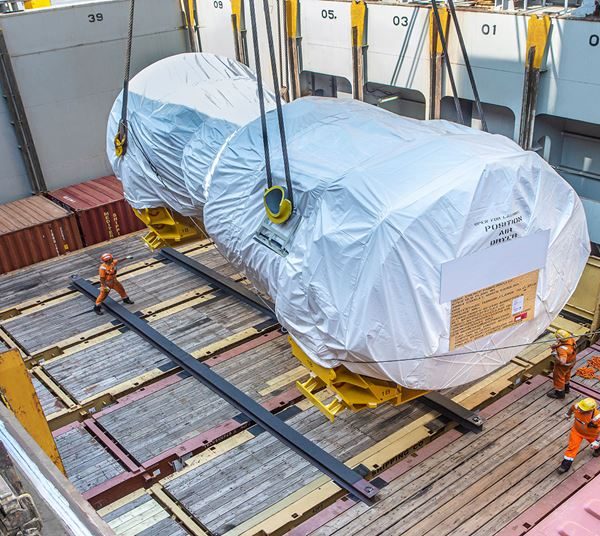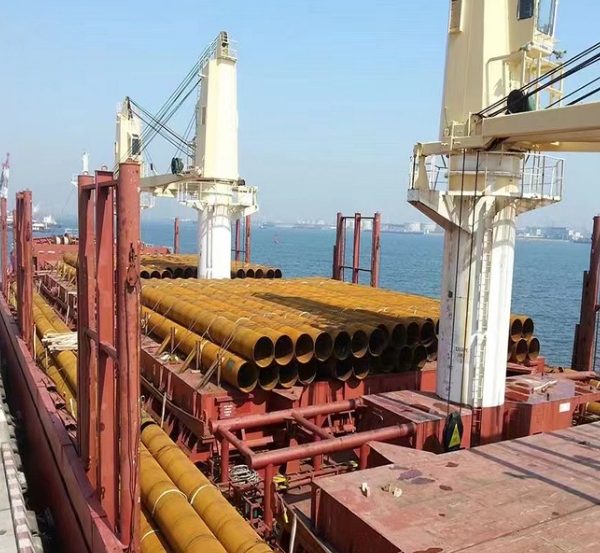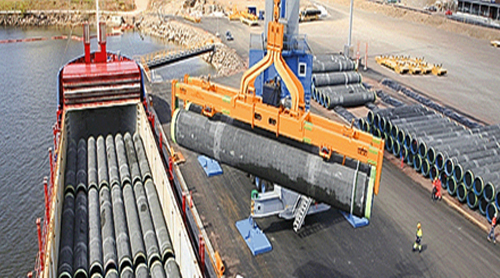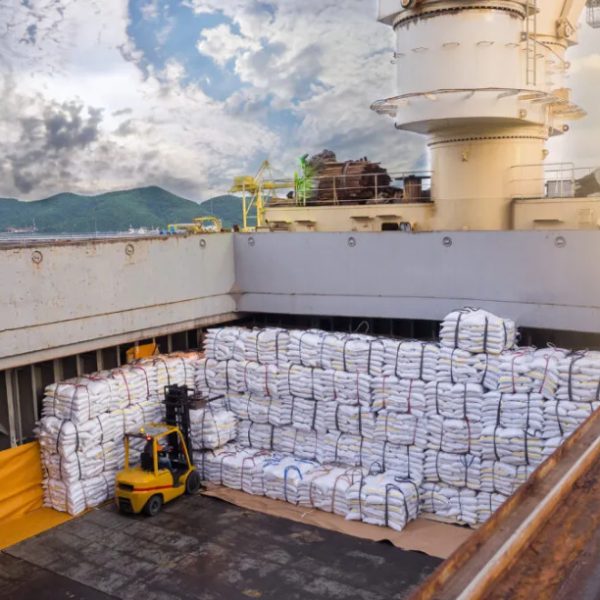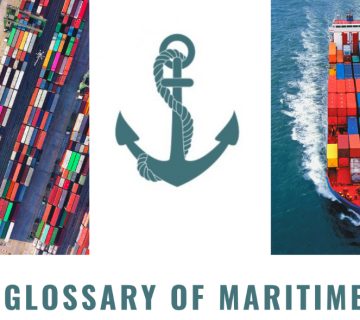What is Breakbulk?
Breakbulk shipping
is a common method used to successfully transport cargo or goods that cannot fit in standard-size shipping containers or cargo bins. Instead, cargo is transported in bags, boxes, crates, drums, barrels, other handling equipment, or is simply rolled, lifted, or pushed onto a ship or barge.
Examples of common breakbulk goods include reels and rolls, steel girders, structural steel, heavy or oversized goods, manufacturing equipment, construction equipment and vehicles. Though the containerization method is one of the more popular shipping methods, breakbulk is noticing an influx of interested shippers with oversized items.
In shipping, break-bulk, breakbulk,[2] or break bulk cargo, also called general cargo, is goods that are stowed on board ship in individually counted units. Traditionally, the large numbers of items are recorded on distinct bills of lading that list them by different commodities.[3] This is in contrast to cargo stowed in modern intermodal containers as well as bulk cargo, which goes directly, unpackaged and in large quantities, into a ship’s hold(s), measured by volume or weight (for instance, oil or grain).
The term break-bulk derives from the phrase breaking bulk, a term for unloading part of a ship’s cargo, or commencing unloading the cargo. Ships carrying break-bulk cargo are often called general cargo ships.
Break-bulk/general cargo consists of goods transported, stowed and handled piecemeal to some degree, typically bundled somehow in unit loads for hoisting, either with cargo nets, slings, or crates, or stacked on trays, pallets or skids.[4] Furthermore, batches of break-bulk goods are frequently packaged in smaller containers: bags, boxes, cartons, crates, drums, or barrels/vats.
Ideally, break-bulk cargo is lifted directly into and out of a vessel’s holds, and this is mostly the case today. Otherwise, it must be lifted onto and off its deck, by cranes or derricks present on the dock or on the ship itself. If hoisted on deck rather than straight into the hold, liftable or rollable goods then have to be man-handled and stowed competently by stevedores. Securing break-bulk and general freight inside a vessel includes the use of dunnage. When no hoisting equipment is available, break bulk has traditionally been manually carried on and off ship, over a plank, or it might be passed from man to man via a human chain.
Bagged cargo
Bagged cargo (e.g. coffee in sacks) is stowed on double dunnage and kept clear of the ship’s sides and bulk heads. Bags are kept away from pillars and stanchions by covering it with matting or waterproof paper.[7]
Baled goods
Baled goods are stowed on single dunnage at least 50 mm (2 in) thick. The bales must be clean with all the bands intact. Stained or oily bales are rejected. All fibres can absorb oil and are liable to spontaneous combustion. As a result, they are kept clear of any new paintwork. Bales close to the deckhead are covered to prevent damage by dripping sweat.[8]
Barrels and casks
Wooden barrels are stowed on their sides on “beds” of dunnage which keeps the middle of the side (the bilge) off the deck and they are stowed with the bung at the top. To prevent movement, wedges called quoins are put in on top of the “beds”. Barrels should be stowed fore and aft and not athwart ships. Once the first tier has been loaded, the next tier of barrels fits into the hollows between the barrels; this is known as stowing “bilge and cantline”.[9] Barrels which are also known as casks or tuns are primarily used for transporting liquids such as wine, water, brandy, whiskey, and even oil. They are usually built in a spherical shape to make them easier to roll and have less friction when changing direction.
Corrugated boxes
Corrugated boxes are stowed on a good layer of dunnage and kept clear of any moisture. Military and weather-resistant grades of corrugated fiberboard are available. They are not overstowed with anything other than similar boxes. They are frequently loaded on pallets to form a unit load; if so the slings that are used to load the cargo are frequently left on to facilitate discharge.[10]
Wooden shipping containers
Wooden boxes or crates are stowed on double dunnage in the holds and single dunnage in the ‘tween decks. Heavy boxes are given bottom stowage. The loading slings are often left on to aid discharge.[10]
Drums
Metal drums are stowed on end with dunnage between tiers, in the longitudinal space of the ship.[11]
Paper reels
Reels or rolls are generally stowed on their sides and care is taken to make sure they are not crushed.[12]
Motor vehicles
Automobiles are lifted on board and then secured using lashings. Great care is taken to prevent damage.[13] Vehicles are prepared by removing hazardous liquids (gasoline, etc.). This is in contrast to ro-ro (roll-on/roll-off) vessels where vehicles are driven on and off the ship under their own power.
Steel girders
Any long heavy items are stowed fore and aft. If they are stowed athwart ships they are liable to shift if the ship rolls heavily, and could pierce through the side of the ship.
Advantages and disadvantages
The biggest disadvantage with breakbulk is that it requires more resources at the wharves at both ends of a ship’s journey—longshoremen, loading cranes, warehouses, transport vehicles—and often takes up more dock space due to multiple vessels carrying multiple loads of breakbulk cargo. Indeed, the decline of breakbulk did not start with containerisation; rather, the advent of tankers and bulk carriers reduced the need for transporting liquids in barrels and grains in sacks. Such tankers and carriers use specialised ships and shore facilities to deliver larger amounts of cargo to the dock and effect faster turnarounds with fewer personnel once the ship arrives; however, they do require large initial investments in ships, machinery, and training, slowing their spread to areas where funds to overhaul port operations and/or training for dock personnel in the handling of cargo on the newer vessels may not be available. As modernization of ports and shipping fleets spreads across the world, the advantages of using containerization and specialized ships over break-bulk has sped the overall decline of break-bulk operations around the world. In all, the new systems have reduced costs as well as spillage and turnaround times; in the case of containerisation, damage and theft as well.[citation needed]
Breakbulk continues to hold an advantage in areas where port development has not kept pace with shipping technology; break-bulk shipping requires relatively minimal shore facilities—a wharf for the ship to tie to, dock workers to assist in unloading, warehouses to store materials for later reloading onto other forms of transport. As a result, there are still some areas where break-bulk shipping continues to thrive. Goods shipped break-bulk can also be offloaded onto smaller vessels and lighters for transport into even the most minimally-developed port which the normally large container ships, tankers, and bulk carriers might not be able to access due to size and/or water depth.[citation needed] In addition, some ports capable of accepting larger container ships/tankers/bulk transporters still require goods to be offloaded in break-bulk fashion; for example, in the outlying islands of Tuvalu, fuel oil for the power stations is delivered in bulk but has to be offloaded in barrels.
If you think this post is useful Please rate us
Your page rank:
